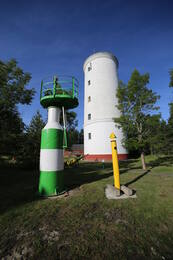Tankų užmėtymas akmenimis
Sovietmečiu visa Kuržemės pakrantė buvo uždara zona. Vaikai, gyvenę netoli sovietų armijos dalinio Targalės valsčiuje, įskaitant Oviši, smagiai leisdavo laiką mėtydami akmenis į tankus.
Sovietmečiu visa Kuržemės pakrantė buvo uždara zona. Vaikai, gyvenantys netoli sovietų armijos dalinio Targalėje, smagiai mėtydavo akmenis į tankus. Jei juos pagausdavo armija, jie turėdavo lupti bulves armijos skyriuje.
Susijusi laiko juosta
Susijusios temos
Susijusios vietos
Oviši švyturys ir sovietinė pasienio apsauga
Ovišų švyturys yra Tārgalės valsčiuje, Ovišų kaime, Kuržemės pakrantėje. Jis buvo pastatytas 1814 m. ir yra seniausias švyturys Latvijoje. Ovišų švyturio bokšto aukštis yra 37 m. Švyturys yra dvigubo cilindro konstrukcijos: jo skersmuo yra 11,5 m, tačiau akmeninėje sienoje yra antras bokštas, kurio skersmuo yra 3,5 m. Tokie dvigubo cilindro švyturiai XVIII–XIX a. Europoje taip pat buvo naudojami kaip gynybiniai statiniai priešo atakų atveju. Ovišų švyturio muziejus laikomas didžiausia švyturio įrangos ir jūrų navigacijos daiktų kolekcija tarp visų Latvijos švyturių muziejų. Geru oru iš Ovišų švyturio galima pamatyti Irbės švyturį.
Antrojo pasaulinio karo pabaigoje netoli Ovišų švyturio buvo įsikūręs Vokietijos armijos Bemingerio bataliono štabas kartu su 530-osios jūrų artilerijos divizijos 4-ąja baterija su keliais priešlėktuviniais pabūklais. Pasakojama, kad švyturio papėdėje buvo radijo krypties ieškiklis ir infraraudonųjų spindulių aptikimo stotis „Donau Gerät“. Netoli švyturio kadaise buvo įsikūręs sovietinis pasienio apsaugos postas, tačiau nė vienas sovietmečio pastatas neišliko. Ovišų stoties pastatas vis dar yra švyturio teritorijoje.






